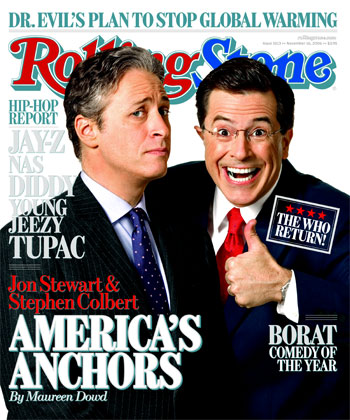Many of my fellow bloggers believed that satirical news is just as reliable as traditional news reporting though it depends on the person or age group concerning them with satirical news. Satirical news can also be known as “fake news” and can be seen through shows that irreverently imitate the real news we see on television. Examples of popular fake news are shows like: The Daily Show with Jon Stewart and The Colbert Report. There were vast majority of different viewpoints on the reliability of satirical news however to my understanding, I contemplate that satirical news can be over exaggerated although helpful to the public sphere when it comes to generating popularity and awareness about the news on a global scale.
As I was reading my classmates’ blogs, I found an interesting example that Alana Lutz pointed out. She uses Rob Ford as an example and mentioned that “The information that they feed to the public sphere may or may not be completely accurate, but it definitely informs the public of what is going on in the world and can therefore be considered useful.”(http://itsalanalutz.wordpress.com/). This is a great example because teenagers would not be so interested at watching Rob Ford on the traditional news however with satirical news we are more engaged with our mayor looking like a fool and smoking crack. We laugh and are entertained more with satirical news because of all the comedy and parodies that have been made with news like this which also subconsciously condemning us to realize the hidden messages of the important news in which our mayor has now become very scandalous.
On a general level, I perceived that most of my classmates would agree with me and consider that satirical news can be unreliable. However, a classmate of mine considers that “Fake news should be seen as an art for…they enable individuals to reflect on multiple sides of a problem, rather than to accept dominant ideologies provided by governments and powerful individuals” (http://tizid1995.wordpress.com/about/). This being said, made me change my perception of the viewpoint of satirical news being corrupt into perceive satirical news in a positive perspective. They can very well benefit our society in a way because they make the news less boring, and contrive for viewers in our generation to take notice in what is actually happening around the world, though on a different part of the media spectrum.
“It is so common these days that it cannot be said that it is an ‘obstruction’ against mainstream anymore. It is even something that is now becoming mass-produced” (http://earthtosydney.wordpress.com/). This was quoted by one of my classmates who made a good point stating that satirical news as well as culture jamming is various and continuous cycles that have moved onto becoming mass-produced. Also, another one of my classmate’s said that “When watching these reports I take the information with a pinch of salt as I know that it is highly opinionated and not always the entire truth…” (http://st12tq.wordpress.com). As things are becoming mass-produced, we take in everything we can without even thinking at times because of how we have accumulated all of the information we get from the news especially emphasized by satirical news.
Regardless of satirical news and their humorous efforts, fake news shows are recognized as a dynamic voice of difference in this generation where we have some people believing in the popular media rather than traditional news discussing politics and such. Society views the media as a sagacious source of information and satirical news will try to appeal to the audience by any means necessary.
